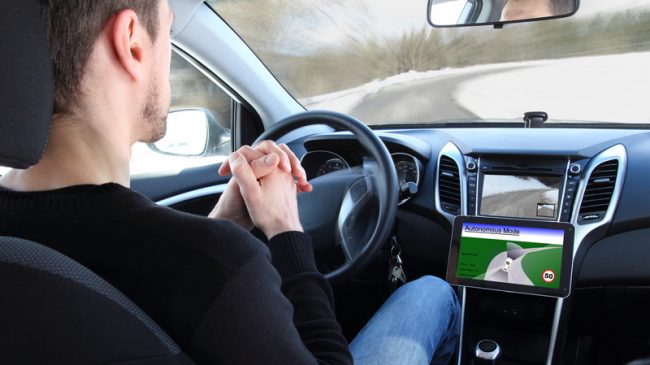Earlier this week NHTSA released a rule that would advance the deployment of connected vehicle technologies. While the proposed rulemaking that would enable vehicle to vehicle (V2V) communication technology on all new light-duty vehicles is questionable, the technology that NHTSA’s is planning on using for the rule is beyond ridiculous. The Trump administration should ensure that this regulation mandating vehicle to infrastructure communications using dedicated short range communication (DSRC) technology never sees the light of day.
Before I detail the stupidity of NHTSA’s rule, let’s discuss the complex worlds of automated and connected vehicles.
V2V technologies and vehicle to infrastructure (V2I) technologies are part of a suite of connected car technologies known as vehicle to infrastructure (V2X) communications. While automated and connected vehicles are being developed at the same time, they are two separate technologies. Automated vehicles, made by Google and Tesla, do not need connected vehicle technology because the vehicle uses external sensing systems (LIDAR, Radar, Ultrasonic and Passive Visual) to stay in the proper lane and avoid vehicle crashes. While these systems are far from perfect, as Tesla’s fatal crash earlier this year shows, it is only a matter of time before these technologies could be ready for use in true Society of Automotive Engineers (SAE) level 5 automated vehicles.
Connected vehicles, on the other hand, do not need to be automated. Safety advocates’ vision is for such vehicles to communicate with each other and roadside infrastructure as well as transmit information to the human driver.
While NHTSA is quick to point out that 94% of crashes are caused by human error, it is unclear how many crashes connected vehicles could prevent that automated vehicles could not prevent. (It is also unclear how many crashes automated or connected vehicles could cause due to defective software or machine learning issues).
Muddying the waters, some aspects of connected vehicles are very useful. V2V technology may be needed by traditional automakers (Ford, Toyota, Etc.) that are not using external sensing systems to build automated vehicles. Vehicles connected with V2V technology could follow each other more closely increasing roadway capacity by approximately 300%. Unconnected automated vehicles will have the same following distances as today’s human operated vehicles and will do nothing to increase roadway capacity.
V2I technology, on the other hand, offers few real benefits and it should not be rolled out until 1) It actually works and 2) There is a legitimate cost-benefit case for the technology which there is not today.
Currently, there is no market for V2I. Automakers are interested in AVs and somewhat interested in V2V technology because it allows them to sell something that consumers want. People will pay for the convenience of an automated vehicle or reduced traffic congestion due to V2V. But some aspects of V2V and all aspects of V2I are advanced safety features that few drivers see the need to pay for.
Further, NHTSA’s 2019 V2I mandate includes the usage of dedicated short-range communications (DSRC) on the 5.9 Ghz spectrum. This brings up several problems. First, DSRC is an old technology that is already out of date. Several newer technologies are or will soon be available. 6G, the soon to be released sixth generation of cellular wireless technology forecast to be on the market by 2019, will provide reliable communication between vehicles traveling throughout the U.S.
Second, due to the competition for wireless spectrum and the fact that the intelligent transportation systems world has had the 5.9 Ghz spectrum for 16 years and hasn’t used it, the Federal Communications Commission wants to open the spectrum to Gigabyte internet among other uses. DOT isn’t thrilled with that idea under any circumstances, because it argues the 5.9 Ghz spectrum should be dedicated to automotive connectivity. Further, DOT threatened to sue the FCC if there is any interference with automotive uses. Putting aside the spectacle of government agencies suing each other, and the controversy of whether the 5.9 Ghz spectrum was ever intended for safety features (some argue it was designed for navigation assistance and drivers advisories features that are widely available outside the spectrum), why is NHTSA so bent on protecting spectrum for an out-of-date technology? Perhaps a lawsuit would make sense if DSRC was some revolutionary connected vehicle technology, but it isn’t.
Then there is the matter of security. All of these technologies make tempting targets for hackers. Taking control of a car’s navigation system is possible today using a certain type of pen that makes the vehicle think there was another vehicle in front of it. Connected vehicles can also capture personal information from each other. Most of these issues are fixable. But it will take time to find and identify all of them, which suggests we should proceed cautiously with connectivity. USDOT is in the business of safety, but it should also be protecting customer’s information. As such, rushing forward with V2V does not make much sense.
NHTSA wants to mandate a certain type of outdated technology that marginally improves the safety of an already safe system. Further, the technology does not adequately protect its user’s cybersecurity and might result in the government suing itself. What could possibly go wrong? More telling, does anybody outside of DOT think this is a good idea?

